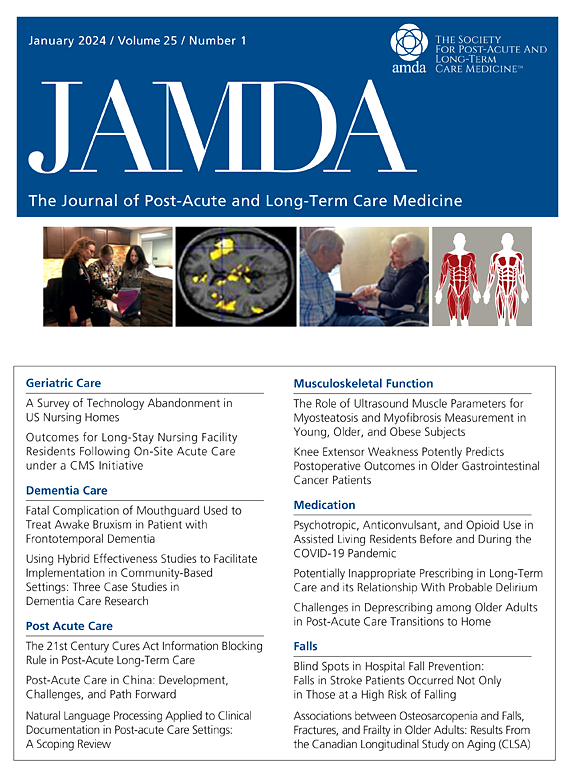Effects of Hand Strength and Walking Speed Combined and in Isolation on the Prediction of Cognitive Decline and Dementia in Middle-Aged and Older Adults: A Systematic Review and Meta-Analysis
IF 4.2
2区 医学
Q2 GERIATRICS & GERONTOLOGY
Journal of the American Medical Directors Association
Pub Date : 2025-05-13
DOI:10.1016/j.jamda.2025.105576
引用次数: 0
Abstract
Objective
This review aims to further elucidate the relationship between reduced walking speed and grip function and cognitive decline.
Design
Systematic review and meta-analysis.
Settings and Participants
Adults without dementia.
Methods
Six English databases were searched from inception to January 2025. Longitudinal studies that simultaneously investigate the relationship between a decline in grip strength or walking speed and cognitive impairment or dementia were eligible. The meta-analysis was conducted using Stata 17.0. The Newcastle-Ottawa Scale and Grading of Recommendations Assessment, Development, and Evaluation (GRADE) approach were used to assess the quality of evidence in the included studies.
Results
A total of 2779 articles were identified through the search strategy. After removing duplicate titles and completing screening, 10 studies were included. Random effects analysis revealed that decreases in physical function [walking speed: hazard ratio (HR), 1.34; 95% CI, 1.13–1.60] and grip strength: HR, 1.30; 95% CI, 1.14–1.49) were significantly associated with decreases in cognitive ability, and this correlation became even more pronounced when pace and grip strength were assessed jointly (HR, 2.72; 95% CI, 1.20-6.17). The results of the subgroup analysis revealed that the study location, follow-up time, cognitive assessment method, sex ratio of the subjects, and other factors affected the results of the study.
Conclusions and Implications
This study suggests that grip strength and walking speed are important predictors of cognitive decline and dementia, and highlights the significance of the comprehensive assessment. Early intervention before middle-aged and older adults enter the clinical stage of dementia is needed, which requires standardized and rigorous assessment.The sequential relationships between hand strength and walking speed in relation to different developmental stages of dementia, as well as how they can be integrated with objective indicators to facilitate diagnosis, need to be further investigated.
手力量和步行速度联合或单独对预测中老年人认知能力下降和痴呆的影响:系统回顾和荟萃分析
目的:进一步探讨步行速度降低与握力功能和认知能力下降之间的关系。设计:系统回顾和荟萃分析。环境和参与者:无痴呆的成年人。方法:检索自建库至2025年1月的6个英文数据库。同时调查握力或步行速度下降与认知障碍或痴呆之间关系的纵向研究是合格的。meta分析采用Stata 17.0进行。纽卡斯尔-渥太华量表和建议评估、发展和评价分级(GRADE)方法用于评估纳入研究的证据质量。结果:通过搜索策略共识别出2779篇文章。在删除重复标题并完成筛选后,纳入了10项研究。随机效应分析显示身体功能下降(步行速度:风险比[HR], 1.34;95% CI, 1.13-1.60)和握力:HR, 1.30;95% CI, 1.14-1.49)与认知能力下降显著相关,当速度和握力联合评估时,这种相关性变得更加明显(HR, 2.72;95% ci, 1.20-6.17)。亚组分析结果显示,研究地点、随访时间、认知评估方法、受试者性别比例等因素影响研究结果。结论与意义:本研究提示握力和步行速度是认知能力下降和痴呆的重要预测指标,并强调了综合评估的意义。需要在中老年人痴呆进入临床阶段之前进行早期干预,这需要规范和严格的评估。手力量和步行速度与痴呆不同发展阶段之间的顺序关系,以及如何将其与客观指标相结合以促进诊断,需要进一步研究。
本文章由计算机程序翻译,如有差异,请以英文原文为准。
求助全文
约1分钟内获得全文
求助全文
来源期刊
CiteScore
11.10
自引率
6.60%
发文量
472
审稿时长
44 days
期刊介绍:
JAMDA, the official journal of AMDA - The Society for Post-Acute and Long-Term Care Medicine, is a leading peer-reviewed publication that offers practical information and research geared towards healthcare professionals in the post-acute and long-term care fields. It is also a valuable resource for policy-makers, organizational leaders, educators, and advocates.
The journal provides essential information for various healthcare professionals such as medical directors, attending physicians, nurses, consultant pharmacists, geriatric psychiatrists, nurse practitioners, physician assistants, physical and occupational therapists, social workers, and others involved in providing, overseeing, and promoting quality

 求助内容:
求助内容: 应助结果提醒方式:
应助结果提醒方式:


